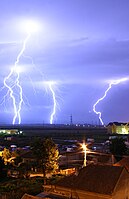
Photo from wikipedia
Using 24 years of cloud fraction (CF) data from the International Satellite Cloud Climatology Project (ISCCP) observations and their corresponding simulators in general circulation models (GCMs) from the Coupled Model Intercomparison… Click to show full abstract
Using 24 years of cloud fraction (CF) data from the International Satellite Cloud Climatology Project (ISCCP) observations and their corresponding simulators in general circulation models (GCMs) from the Coupled Model Intercomparison Project phase 5 (CMIP5), we have analyzed cloud biases and their role on radiation over the Indian region (65–100° E and 5–40° N) for the monsoon season of June to September. The present study reports the spatial patterns of CFs and their biases in GCMs compared to observations. It is found that the simulated CFs are highly underestimated up to ~ 40%. Mean of total CF from ISCCP observations is 75% with at least 10% difference with simulated CFs. For high-topped clouds, this difference is about 3–4%. Except for high-topped clouds, other cloud types are not simulated realistically by CMIP5 models used in this study. Further, we investigated the individual cloud types classified based on cloud optical depth and cloud top pressure. We found that, in general, individual cloud types are poorly simulated by models, although some (Max Planck Institute Earth System Model, Low Resolution and Hadley Centre Global Environmental Model, version 2, Earth System) models convincingly simulate high-topped thin clouds. To assess the impact of cloud biases on the simulated radiative forcings, we studied shortwave and longwave cloud radiative forcings from CERES (Clouds and the Earth’s Radiant Energy System) observations and CMIP5 GCMs. It is noticed that the spatial patterns of biases in radiative forcings are similar to the patterns of biases in CFs for high-topped clouds, specifically over the oceanic regions. We find that the biases in cloud radiative forcings could potentially be caused due to the inefficacy of CMIP5 models in simulating high-topped anvil clouds (high-topped cirrus/stratocirrus clouds). The present study confirms that the uncertainty in simulating cloud fractions over the Indian region is still a prominent issue to be addressed in general circulation models.
Journal Title: Theoretical and Applied Climatology
Year Published: 2019
Link to full text (if available)
Share on Social Media: Sign Up to like & get
recommendations!